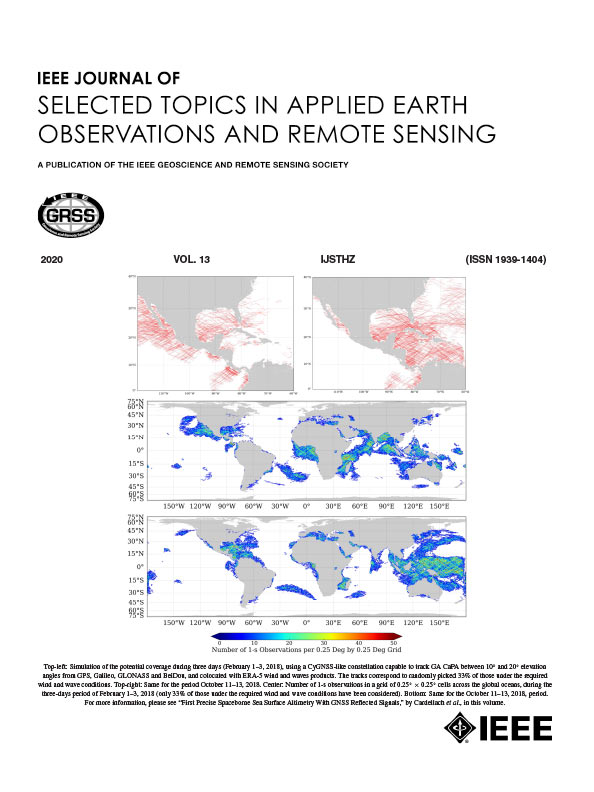利用重建GNSS-R观测资料反演每日9公里土壤水分
IF 5.3
2区 地球科学
Q1 ENGINEERING, ELECTRICAL & ELECTRONIC
IEEE Journal of Selected Topics in Applied Earth Observations and Remote Sensing
Pub Date : 2025-09-18
DOI:10.1109/JSTARS.2025.3611668
引用次数: 0
摘要
星载全球导航卫星系统反射测量(GNSS-R)观测是广泛监测土壤湿度(SM)的有效方法。依赖其他遥感系统的网格数据是GNSS-R SM检索的一般方法。增加网格大小可以提高时间覆盖率,但降低空间分辨率,这可能掩盖网格内SM的变化。相反,更细的网格导致更高的空间分辨率,但更低的时间分辨率,导致SM时间动态的不连续。因此,GNSS-R观测网格无法同时实现高时空分辨率。为了充分发挥GNSS-R技术在高时空分辨率SM检索中的潜力,本研究引入了一种星载GNSS-R观测数据重构方法,生成高时空分辨率的网格化观测数据。利用该方法建立了包含GNSS-R观测特征及其驱动因素的逐像素多元时间拟合模型。具体而言,本研究利用气旋GNSS (CYGNSS)滑动平均观测来补充日趋势观测,并整合其他卫星任务的辅助数据作为日变率的调整,从而产生时空无缝的CYGNSS观测。然后利用重建的CYGNSS观测数据在9 km网格上提供每日准全球SM检索。均方根误差(RMSE)为0.052 $\mathrm{c}{\mathrm{m}}^{3}}{\rm{/c}}{{\mathrm{m}}^{3}}$,与重建前的SM检索精度相当。同样,对局部原位点的独立评价表明,SM检索的RMSE和相关R分别为0.051 $\mathrm{c}{{\mathrm{m}}^{3}}{\rm{/c}}{{\mathrm{m}}^{3}}$和0.77。从CYGNSS观测数据中提取的SM也捕获了局部干湿动态,这与从原始CYGNSS观测数据中提取的SM的性能一致。值得注意的是,时间分辨率比原来的CYGNSS 9公里观测值提高了258%。因此,我们认为本研究中使用的方法在不损失SM检索精度的情况下解决了准全球CYGNSS SM检索中时空分辨率相互约束的问题。此外,本研究开发的观测重建方法对于GNSS-R域中其他高时空分辨率地球物理参数的监测也有一定的参考价值。本文章由计算机程序翻译,如有差异,请以英文原文为准。
Daily 9-km Soil Moisture Retrieval With Reconstructed GNSS-R Observations
Spaceborne global navigation satellite system-reflectometry (GNSS-R) observations are effective for extensive monitoring of soil moisture (SM). Reliance on gridded data from other remote-sensing systems is the general way of GNSS-R SM retrieval. Increasing the grid size improves temporal coverage but decreases spatial resolution, which may mask changes in SM within the grid. Conversely, finer grids result in higher spatial resolution but less temporal resolution, leading to discontinuities in SM temporal dynamics. Therefore, GNSS-R observation gridding cannot achieve high spatiotemporal resolutions simultaneously. To leverage the potential of GNSS-R technology in SM retrieval with a high spatiotemporal resolution, this study introduced a reconstruction method for spaceborne GNSS-R observations to generate gridded observations with both high temporal and spatial resolution. This method was used to build a pixel-by-pixel multivariate temporal fitting model that incorporates the characteristics of GNSS-R observations and the associated driving factors. Specifically, this study utilizes cyclone GNSS (CYGNSS) sliding average observations to supplement daily trend observations and integrates ancillary data from other satellite missions as adjustments to daily variability, which generates spatiotemporally seamless CYGNSS observations. The reconstructed CYGNSS observations were then utilized to provide daily quasi-global SM retrievals on a 9-km grid. The root-mean-square error (RMSE) of the SM retrievals was 0.052 $\mathrm{c}{{\mathrm{m}}^{3}}{\rm{/c}}{{\mathrm{m}}^{3}}$ R) of the SM retrieval were 0.051 $\mathrm{c}{{\mathrm{m}}^{3}}{\rm{/c}}{{\mathrm{m}}^{3}}$
求助全文
通过发布文献求助,成功后即可免费获取论文全文。
去求助
来源期刊
CiteScore
9.30
自引率
10.90%
发文量
563
审稿时长
4.7 months
期刊介绍:
The IEEE Journal of Selected Topics in Applied Earth Observations and Remote Sensing addresses the growing field of applications in Earth observations and remote sensing, and also provides a venue for the rapidly expanding special issues that are being sponsored by the IEEE Geosciences and Remote Sensing Society. The journal draws upon the experience of the highly successful “IEEE Transactions on Geoscience and Remote Sensing” and provide a complementary medium for the wide range of topics in applied earth observations. The ‘Applications’ areas encompasses the societal benefit areas of the Global Earth Observations Systems of Systems (GEOSS) program. Through deliberations over two years, ministers from 50 countries agreed to identify nine areas where Earth observation could positively impact the quality of life and health of their respective countries. Some of these are areas not traditionally addressed in the IEEE context. These include biodiversity, health and climate. Yet it is the skill sets of IEEE members, in areas such as observations, communications, computers, signal processing, standards and ocean engineering, that form the technical underpinnings of GEOSS. Thus, the Journal attracts a broad range of interests that serves both present members in new ways and expands the IEEE visibility into new areas.

 求助内容:
求助内容: 应助结果提醒方式:
应助结果提醒方式:


